Collaboration and immersion in a diverse community: Waring School, where “oui” means “us,” all of us.
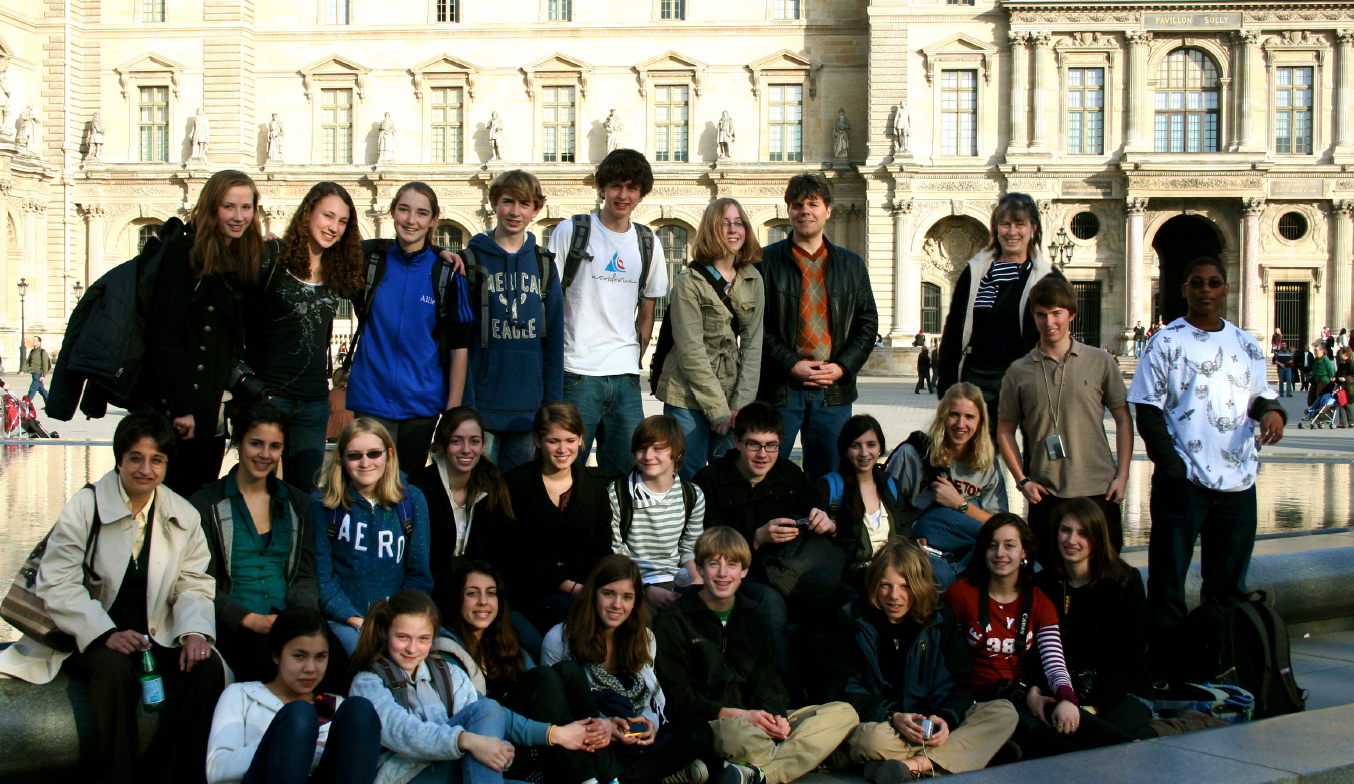
Abstract
This paper presents how French is taught at Waring School along with the benefits and challenges of studying French in a world that focuses increasingly on a narrowed sense of the usefulness of learning in general. The usefulness of learning French will be presented with research noting the benefits of an immersion program on a student’s cognitive, communication, and thinking skills beyond the learning of the language. Observations at Waring School corroborate research that notes the power of motivation and willingness to participate in predicting a student’s success in learning French. This paper explores how to harness that motivation through a teacher’s collaboration with students.
This article will discuss how learning a language builds a sense of community by encouraging the discovery of the self and of the other, and how Waring embraces this opportunity to build a caring and open community across all disciplines. This paper also provides support for learning French being a personal journey that requires diversified and individualized teaching. It is argued that an increased awareness of students’ learning styles and study needs, coupled with evolving technologies and teaching trends, require an intense, flexible teaching program that is built upon a strong pedagogical philosophy and institutional support.
Introduction
Everyone studies French at Waring School. It is the school’s only foreign language offered. Behind this decision lies both the history of the school (its co-founder Josée Waring is French) and the ongoing belief that a common second language builds our sense of community.
For the purposes of this article, the word diverse is used to mean students who have different learning styles as well as different cultural backgrounds. At Waring School, we believe all students can learn French, yet we encounter challenges both in promoting that belief and in achieving it. We see the impact of enthusiasm, and on occasion, the negative aspects of self-defeating approaches, to learning French. We believe that to teach an effective French class, one must first build a safe and respectful learning environment. We also believe that the skills we build to listen and respond to each other in the classroom build a caring community outside of the classroom; a shared goal across Waring School. We see that our cultural explorations open the door to a better understanding of different ideas and traditions. French at Waring School is not just one aspect of the school, but is deeply enmeshed in how we as a community build up our students as individual learners and caring citizens.
How We Teach
Prosody
Step into a new world, trust us, stop thinking, relax, have fun, just be! That’s what we tell our new students. From the moment they step into their first French classroom, the students will only hear French, and within minutes, they can respond in full sentences. We keep the tone light and jovial. We ask the questions quickly, using objects and photographs to teach vocabulary. We toss a soft toy back and forth as a way to keep students on their toes, never knowing when they are next to speak. This helps to keep them alert. When we first ask new questions, we offer as examples alternative answers using ourselves as responders for personal questions. Students learn from listening to each other answer similar questions. They soon learn to pick up the French language patterns and intonation. By the end of the first class, students can respond quickly to a few questions. By the end of the first week, they can hold a basic conversation. After a few weeks, they are ready to perform skits in front of their families. How is this achieved?
In her presentation at a Massachusetts Foreign Language Association (MaFla) teacher conference, then Department Chair Allegra Smick (2004) explained that the Waring School French program “prioritized oral language as the primary target of learning” (p.2). Our goals have not changed. Smick (2004) explained the importance of hearing a language as much as possible in order to pick up its rhythm, stress on syllables, and intonation. This is called the prosody of a language. It is not unusual to be asked a grammar or vocabulary question by more advanced students about something they have written, and when they are asked to read that sentence out loud, they will often hear the correct answer and be able to correct the sentence themselves. The intense exposure to hearing and speaking French from the onset drives their ability to intuitively understand an increasingly sophisticated vocabulary and grammar. Indeed, Smick (2004) claimed that “no speaker can be truly fluent as long as they are translating from English to the target language” (p.4). We continue to find that students who translate before speaking French are at a significant disadvantage to their peers. This is why it is key for the Waring School French program to lead classes entirely in French from the onset. It is in order to encourage thinking directly in French that we continue to hone our techniques of systematization.
Systematization
Even in our most advanced classes in which students speak and write with relative fluency, the systematization of learning new materials is our goal. Systematization means the materials have been reviewed in a number of ways, usually from helping a student to discover the why and how of the new materials to applying the new materials in a variety of applications so their use and understanding become instinctive. One example of how we achieve this in our French classes at Waring School would be when we play Tic, Tac, Toe at the end of a class. This might sound like a trivial activity. It is indeed a game, and it is fun. However, the questions asked in order to earn an X or an O are review questions of the materials learned in class. The questions are asked fast, and often reworded shortly after. In the end, focus, intuition and quick participation while playing facilitate the systematization of that day’s learning. Often what seems like mere fun in a French class is a song picked for its vocabulary, a game chosen to encourage dialogue, a video introducing a new cultural exploration that will then be discussed with a text or poem.
In addition, we see the benefits of another kind of fun: learning with movement. Any adult who has been asked to attend a conference will often complain about the discomfort of sitting down after even just one hour of lectures. Somehow we expect our athletic teenagers to cope better with this challenge. In our classrooms, we see the benefits of interrupting the traditional sitting with alternate learning exercises. In a recent article, Reynolds (2018) reports that “many past studies have shown that exercise prompts the release of multiple neurochemicals in the brain that increase the number of new brain cells and the connections between neurons.” He goes on to discuss how this increased brain plasticity augments a person’s ability to learn; not only did researchers ascertain that students who were physically active while learning were able to learn more vocabulary, they were able to retain it longer and to have a deeper grasp of how to use the new vocabulary. This might well be an invitation for increased physical activity at all levels of French classes at Waring School as it tends to wane as the classes become more advanced.
In his work on Systematization, Decoo (2011) argues that successful systematization requires allowing for repetitions of previously learned materials as well as the careful introduction of new materials (p.166). At Waring School, we have the added challenge that we adapt our classes each year to the interests of the students in a class and their abilities. As students move from one teacher to the other from year to year, there is the challenge of making sure there is a well-organized continuum of materials studied. At Waring School, we address this by filling out a detailed summary of what was done in each class that is then shared within the French department.
Another challenge is that our immersion techniques for beginners work best in a class size of twelve students or less – a threshold we aspire to maintain as possible. This is a privilege that is often but not always met. It can be a challenge to teach as effectively as we would like to in those instances, and on a number of occasions we have taken to adding teacher assistants for larger classes.
The dance between revisiting familiar materials while introducing new ones is well known to our students. An example of this would be how we introduce new verb tenses. After two years spent at the Beginner I and II levels, we spend the first two years at the Intermediate level “not moving past” studying the Passé Composé, Imparfait, Présent and Futur Simple. This can seem to be repetitive if only looking at the nature of what is being studied. However, by the time the students reach the Intermediate III level, they have seen those verb tenses in myriad forms, texts, songs, and used them in writing so often and with such increasing sophistication, that they are ready to juggle those tenses with relative mastery and to conjugate a long list of irregular verbs. At the Intermediate III levels, the now systematized knowledge of those first verb tenses allows the students to be catapulted into an exciting array of new tenses that many will master with relative ease, including the conditional and subjunctive tenses. By the time our students reach our upper Intermediate and Advanced levels, many can read complex texts, write with elegance and accuracy, and participate in animated discussions with an impressive fluency.
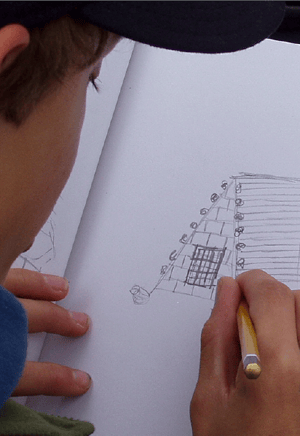
Sensing usefulness: the power of motivation
Why do some students find it easier than others to speak French? Why can some students relax and have fun and others hold on to English with a high level of anxiety? What is aptitude and where does attitude affect the outcome of a student’s learning? While these are broad questions that merit in-depth answers, this paper focuses on how to approach each student’s learning needs with compassion and ambition and also to offer a window into some challenges and potential solutions we can embrace.
The power of motivation
In a paper comparing how immigrant students performed when studying French in Canada compared to their Canadian-born English-speaking peers, Mady (2015) examined how the immigrant students clearly outperformed their peers (pp. 298-308). Some of her observations seem to be widely applicable, including to the students and teachers at Waring School.
Keys to the success of the immigrant students included: more motivation, less anxiety, a willingness to communicate and a more positive attitude. In addition, Mady (2015) cites research that has demonstrated that bilinguals have an advantage when learning a new language due both to an increased metalinguistic ability (ability to manipulate the language) and increased motivation. Mady posits that immigrants see Canada as a bilingual society and so are equally motivated to learn English and French, whereas Canadian-born English-speaking students might have a more relative or personalized sense of the usefulness of learning French. At Waring School, students learn by participating, listening for patterns, and learning from mistakes. When a student comes to class ready to connect with the French language in this way, that student will make quick progress. If a student is hampered by an anxiety that clings to English or by low self-esteem as a French learner, that lack of positive self-motivation will act as a powerful barrier to that student’s progress. Seeing this behavior and reaching out to the student to break that pattern through encouragement and individualized learning has proven effective in many cases at Waring School, even when that behavior has become entrenched.
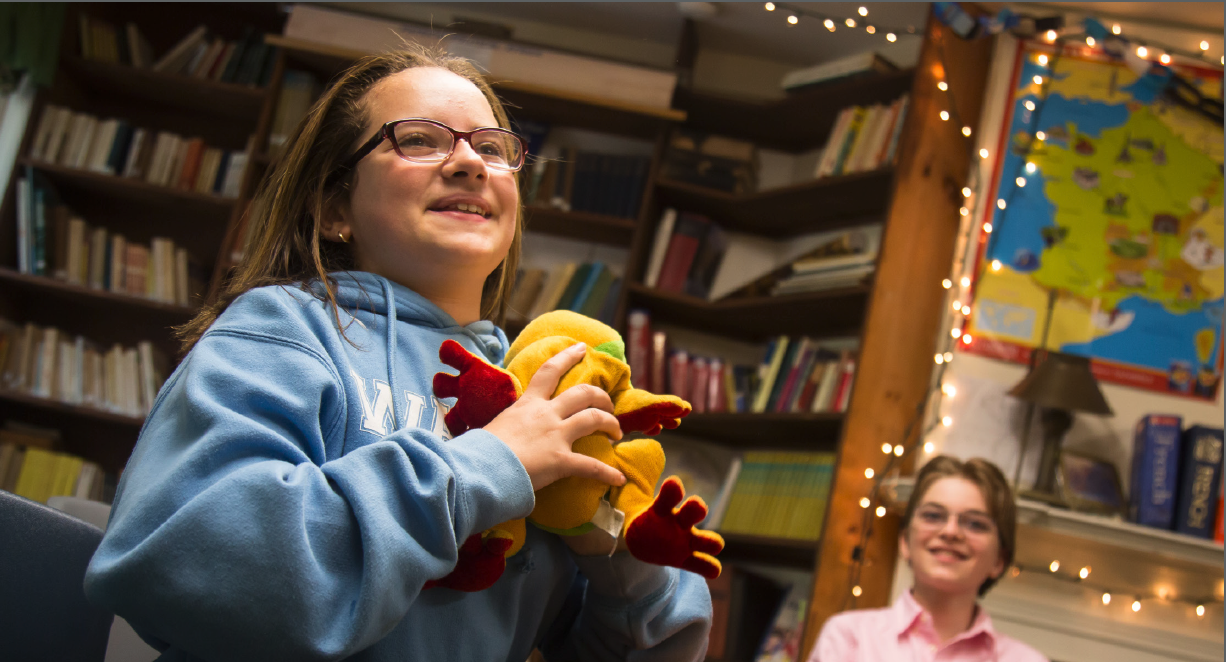
Visible institutional support is a powerful motivator
At Waring School, there is support for the French program at all levels. The school embraces a program in which all students study the same foreign language and benefit from that shared experience. The rigorous program includes eight hours of French classes each week for sixth and seventh graders, and four hours of French classes for the upper grades. Eighth graders enjoy an additional music immersion class and new upper grade students are offered an art immersion class. Many students are motivated to continue to speak French together for fun outside of the classroom. Students perform French skits in front of each other during All-School Meetings. While performing these skits makes some students nervous, it is more often than not a joyful and humorous community-building experience when we celebrate the language we are learning together.
The administration supports the French department and the effects of this support trickle down to teacher morale and student enthusiasm for their own learning. Recently, after one year of experimenting with reducing an Immersion Humanities class from two to one hours a week for our 6th and 7th graders, and after seeing the negative impacts to the class, the administration responded to the teachers and promptly reestablished the two hours a week. The impact on the effectiveness of the classes was immediately felt as the teachers were once more able to put into effect a more organic as well as systematized form of teaching, and the students were able to relax into the more creatively hands-on classes allowed by the extra class period. Most students respond to the French program and the school’s valuing of the program in their daily schedule by embracing it as an inherent and intrinsic part of their learning experience at Waring School.
Transforming self-defeatism into success
A number of studies show perceived difficulty as a reason for some students’ lack of motivation for learning French. Graham (2004) presents findings that some students may be:
“...prone to low motivation and to passivity in the face of difficulty, with success appearing unattainable. The low levels of effort and strategy attributions may indicate a reluctance to accept responsibility for one’s own lack of success, or a sense of mystification as to how to improve one’s language learning. Possibly these students believe they are trying reasonably hard but are unaware that their efforts are being inappropriately focused” (p. 186).
This lack of self-awareness as a learner or self-defeating anxiety is where we as teachers can step in to build what is called the executive control of one’s own learning. Indeed, we can help our students to build the executive control of their learning by following Graham’s (2004) advice. She argues that the most important approach is to offer learner strategy instruction (LST) which fulfills four distinct needs: “(a) makes learners aware of the possibility of improving their learning by improving strategies appropriately and effectively, (b) models a range of strategies, (c) provides guided practice, and (d) evaluates effectiveness of strategies used on learning outcomes and action-planning for future strategy use” (p. 187).
At Waring School, we at times see some students become unmotivated because they feel incapable compared to their peers. The key to helping these students is to redefine success in the classroom as not being how one does on a standardized test but how one is doing on one’s own personal journey. In a speech to prospective teachers, Dewey (1909) describes what can be found in too many classrooms, where the “fear of losing the approbation of others; or of failure, would become so extreme as to be morbid or paralyzing….The weaker gradually lose their sense of power, and accept a position of continuous and persistent inferiority.” Even with our best intentions and attentions at the Waring School, some students wrestle with similar fears and struggle in French classes. A challenge for teachers is to allay the fears of our students, especially when we are busy and perhaps even tired, for then we tend to resort to teaching in a manner that is familiar to us and can lose sight of diversifying our approaches to teaching.
It is important to acknowledge the difficulties and discomfort some students endure while learning French. We need to encourage each student by engaging them in conversations, giving individualized constructive feedback, and offering alternative methods for learning. One of the most exciting aspects of teaching is when a struggling student has trusted a teacher who has reached out, and when that student has been willing to try to learn in a new manner, and finally connects with the materials being taught.
What is success?
When a teacher can build trust with a student that it is the personal journey as a learner that is important, the student can stop looking at outside validation for success, but look within: what did I learn today? What chance did I take in class? What questions did I ask? A student who has embraced his or her personal journey with French will feel encouraged with each step forward, and see difficulty not as a failure but as a challenge to face and overcome in collaboration with that student’s teacher. At Waring School we see this happen for example when a student is in a class with peers who find it easier to excel in French. That student might have fallen behind in his or her writing and conversational skills and adopted a pattern of shying away from participating in class. A teacher can encourage the student by giving space for individual participation as opposed to asking questions to the whole class that are then usually answered by the same quickest students. Other ways to include participation include assigning interactive exercises that are to be completed with a partner, asking that student questions while offering two alternative answers so the student can repeat the correct answer without stressing about how to phrase it, or simply giving the time to all students to reflect on what they wish to say so they can feel prepared to participate. Likewise, finding the time for a few sessions, be they in class or outside of the class, to go over the basics of grammar or of writing that the student may be missing, hopefully will allow that student to build the foundation needed to make continued progress. In French classes at Waring School, we often differentiate homework expectations and even give separate assignments in order to challenge our students and to help them move forward whether they are excelling in the class, or whether they are still in need of mastering the basics. When this is done in a respectful and encouraging way, students recognize that their personal progress is being noticed and celebrated. They find their identity and voice in the French classroom. We want each student to believe in the possibility of making progress and aim to diversify how we approach teaching students.

Key Points at a Glance
- At Waring, we do not translate or learn in English! Waring uses a never in English approach to teaching French. Only by extensive, immersive exposure to the rhythm, intonation, stresses and syllables of the target language will students internalize authentic prosody.
- Waring teachers use physical activity (learning with movement), games, images, music and dramatization systematically (and at all levels) in their teaching.
- There is widespread institutional support for Waring’s French program with resources to support a robust schedule of language and immersion classes at optimized class sizes.
- Teaching is individualized for the learner; students who may struggle in French are given personalized pathways to success, with intrinsic, cultural motivators for full participation in the program. The 9th grade homestay is a prime example of how experiential learning enables students with all arrays of learning styles to grow and succeed, linguistically, socially, and culturally.
- Many Waring School graduates successfully take on a third foreign language with relative ease due to their experience while at Waring.
- Studies show that students who have multilingual immersion education perform better on cognitive tests (Nicolay and Poncelet, 2012).
- “French Immersion students enjoy significant linguistic, academic, and cognitive benefits” (Lazaruk, 2007, p. 607).
- At Waring School, we mark our success when a student has found his or her voice in French and can find enjoyment in using that language.
- French is among the fastest growing languages world-wide, with one prediction that by 2020, 750 million will speak the language (Gobry, 2014).
At Waring School, we seek to nurture this in our students by adapting to different learning styles within the classroom. We push our strongest students as well as our struggling students. We find that the Focus Flex periods on our weekly schedule during which teachers are available to give individualized instruction to students can be very effective. They have allowed for occasional more individualized support to both struggling students as well as students who are ready for more advanced explorations of the materials presented in class. They are not meant to become sustained private sessions but rather are effective occasional opportunities for individualized attention.
While there is no magic wand, we have seen struggling students turn around and embrace learning French when they have found a way to make it their own. For some students, this has meant that we adapted classroom expectations. A student who has more facility with oral French than with written French will find that we will offer harder challenges orally and offer simpler tasks as writing assignments, but all progress will be noticed and celebrated.
The Waring School French program has a unique tool. Over and above the differentiation we do with our teaching within the classroom, we have a flexible system of moving students from one level to another. For example, a student will typically move up to the next level of French at the beginning of a new school year. However, we on occasion have students who have such a strong intuition for French and ease with grasping new vocabulary and grammar as well as speaking it that it makes more sense to keep them challenged by allowing them to skip a level. We have found that these students often quickly learn the new grammar they need with ease and end up being leaders in their new class. The pitfall of skipping a year is that the student has less exposure to vocabulary and if done more than once, can lead to the student not having the same depth of knowledge of French as his peers. Conversely, students who have not made enough progress in order to build the knowledge-base they will need to succeed at the next level are required to repeat the level. This is not treated as a failure but as an opportunity to continue to build upon what was already acquired. We regularly find that those students are then successful in connecting more deeply with the materials.
How useful is it to learn French?
Why even bother to learn French? Is it useful? Isn’t STEM the future of the world?
In seeking to motivate French learners in a world that defines the usefulness of learning in an increasingly narrow manner, French teachers may find it helpful to share the widespread usefulness of the French language around the world.
One startling prediction is that by 2050, French could be the most-spoken language in the world, ahead of English and even Mandarin. This is predicted in a study by investment bank Natixis and cited by Gobry (2014) who states that French is “growing fast, and growing in the fastest-growing areas of the world, particularly sub-Saharan Africa. The latest projection is that French will be spoken by 750 million people by 2050.” While the Natixis study perhaps unrealistically presumes that the entire population of countries where French is the official language will speak French, it nevertheless reflects that French is a fast-growing and global language.
The following are some examples of the impact of the French language in today’s world:
L’Organisation Internationale de la Francophonie, or OIF, an organization of countries with a French-speaking heritage, has 77 members, or almost a third of the world’s countries.
The France Diplomatie (2018) website lists the following statistics:
- More than 220 million people speak French on the five continents.
- French is the second most widely learned foreign language after English, and the sixth most widely spoken language in the world
- French is the third most widely used language on the Internet after English and German, ahead of Spanish.
- French is a good base for learning other languages, especially Romance languages.
- French is an analytical language that structures thought and develops critical thinking.
French continues to be a language that ties cultures together in each continent. In an introduction to an article in the Economist’s 1843 Magazine on what is the best language to learn, Greene (2012) asserts that “if I was asked what foreign language is the most useful, and given no parameters (where? For what purpose?) my answer would be French.” He continues that French “can enhance your enjoyment of art, history, literature and food, while giving you an important tool in business and a useful one in diplomacy.”
Benefits of immersion extend beyond French
As we seek to motivate French learners, there are a number of highly rewarding personal benefits to studying French that should be shared with students, as seen in the studies of bilingual students.
Enhanced cognitive skills
The benefits of a second-language immersion education are quite stunning beyond speaking the language itself. Nicolay and Poncelet (2012) found in an extensive study that students who had benefited from a second-language immersion education had a reaction time on tests that was significantly faster than those of the monolingual group. This was true on a wide battery of tests such as attention and executive skills, and mental flexibility. These results were true even after only three years in a second-language immersion experience (pp. 597-607).
Another survey of research on French as a second language in Canada suggests that “French Immersion students enjoy significant linguistic, academic, and cognitive benefits.” (Lazaruk, 2007, p. 607). Lazaruk adds that “Cognitive research associates bilingualism with heightened mental flexibility and creative thinking skills, enhanced metalinguistic awareness, and a greater communicative sensitivity” (p. 607). He argues that the “intensity of instruction clearly has a positive effect on language proficiency” (p. 612). This is something we have observed at Waring School. The effectiveness of our French program relies upon the intensity of the frequency of the classes as well as the immersive experience within the classes. Lazaruk cites a study by Peal and Lambert (1962) in which students equally fluent in French and English outperformed monolinguals on 15 of 18 variables measuring IQ. According to Lazaruk , their findings led them to conclude that “bilingual children demonstrate more mental flexibility, an ability to think more independently of words, superiority in concept formation, and a more diversified intelligence than monolingual children do” (p. 617). In the same paper, Lazaruk presents findings that bilingual children are also better at non-verbal problem-solving tasks. This is reflected in the children’s increased flexibility and creativity (p. 621).
Transferable to a new language
Waring School alumni regularly report that how they learned French facilitated their studies of new languages once they had left the school. A number have gone on to study one or more new languages including Arabic, Italian, Spanish, Chinese. They mention that they learned how to connect with a new language, and how those skills have been transferable for them.
Waring alumnus Sam Lasman (class of 2007), who has studied Persian, Arabic and Welsh as well as other languages since leaving Waring School, says:
“I feel that one becomes better at learning a language with each subsequent language one learns. If the languages are related, then of course there are cognates and similar grammar, but even very different languages can share features that English doesn’t have, and encountering these features once – or even simply understanding some of the different possible ways that language can work – provides a huge benefit in learning a new language. I’ve also tried, when possible, to follow some ‘best practices’ of Waring French – trying to pronounce accurately, think in the language, and associate rather than translate vocabulary” (S. Lasman, personal communication, 22 August 2018).
Waring alumna Lillie McDonough (class of 2007) joined the Waring School having already studied another language. From the onset, her talents for learning a new language were apparent. She comments that it is difficult to break down the role of nature vs. nurture in her situation. She sees the self confidence she had in speaking other languages upon leaving the Waring School as boosting her self-confidence to study other languages. She continued to learn other languages with relative ease such as Spanish and Ancient Greek, and then Bulgarian and Italian simply by immersion. She notes the benefits of speaking another language when traveling for simple things such as reading signs or more importantly connecting with strangers and their culture (L. McDonough, personal communication, 26 August 2018).
Heightened social skills
Studies into bilingual children’s social skills suggest another benefit: they have a “heightened sensitivity to verbal and non-verbal cues, and show a greater attention to their listeners’ needs, than monolingual children do” (Lazaruk, 2007, p. 619). This leads to an exploration of learning language in the context of culture.
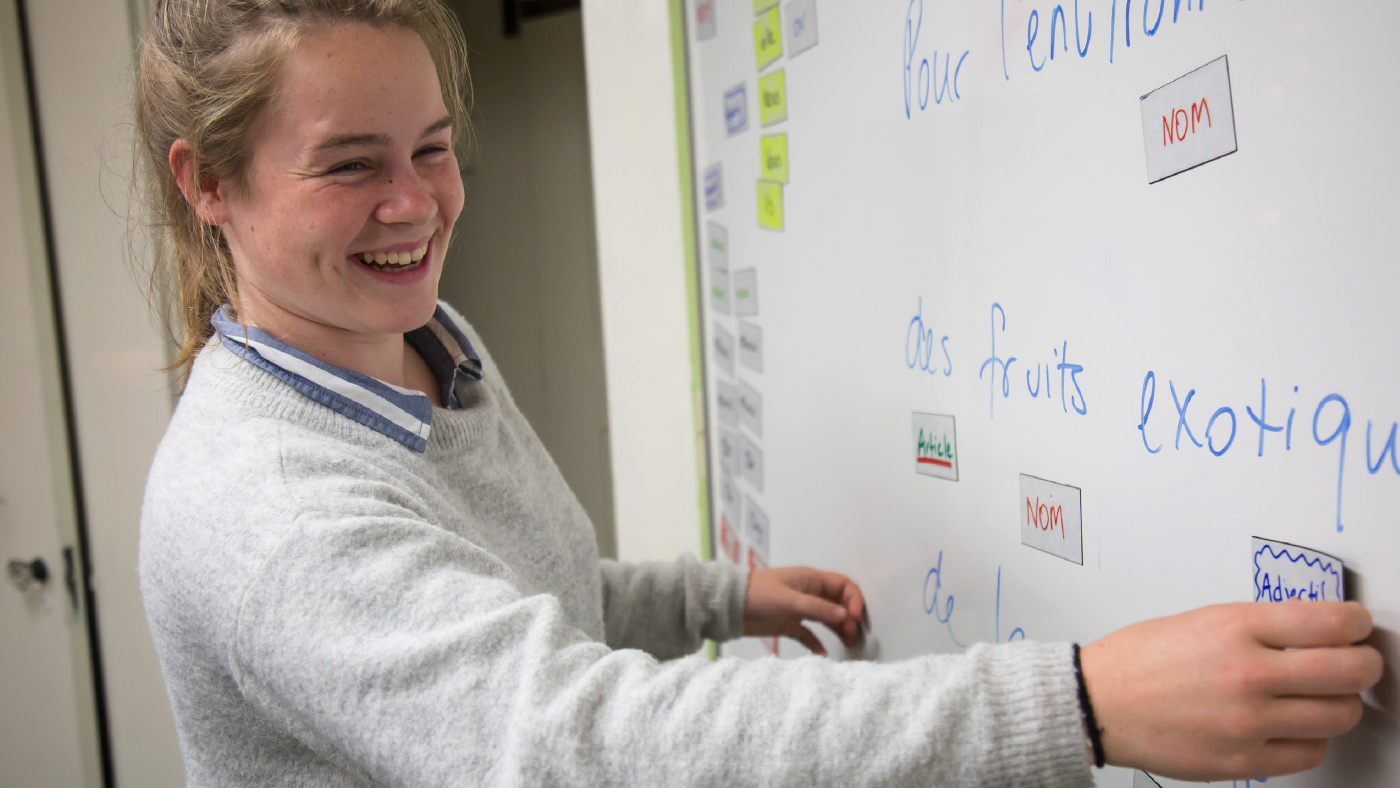
Language and culture
Embracing La Francophonie
An important aspect of learning a language is to learn it in the context of culture, ideally with a view into as many cultures as possible that use that language. In recent years, Waring School has made concerted efforts to move away from a Euro-centric curriculum and to embrace the francophone world. We have forged friendships with members of the Haitian community and enjoy cultural exchanges with them. We have enrolled French-speaking students from the Democratic Republic of the Congo and students with francophone family roots from Haiti, New Brunswick, and Vietnam. We travel to Québec and New Brunswick. We read African poetry, and sing French songs from around La Francophonie. We read the history as well as current events affecting these countries. Waring School explores new cultures within the classroom and also through travel. Our sixth and seventh graders travel to Québec. Waring School has an exchange program with the Lycée David d’Angers, France. Each fall, our ninth graders host a French exchange student for four weeks in their home. The exchange student attends Waring School and speaks English with his or her host student. In the Spring, the roles are reversed. Our ninth-graders go to Angers, France, for four weeks. They are hosted by the family of their French exchange student and now switch to speaking only French with him or her. We have found these immersive experiences to be highly effective in boosting our students’ fluency. In addition, Waring School students enjoy a three week trip typically in France at the end of their Junior year. As a result of these trips, students are encouraged to grow into thoughtful, culturally-proficient, and confident travelers.
A safe classroom
Learning a language begins with the culture inside of the classroom. Key to being able to learn a language is the need to feel safe: safe to make errors, safe from any ridicule, safe to take risks, safe to have fun, safe to offer answers, safe to hesitate, and safe to participate. The tone of the classroom is set by the teacher and the classmates. This goal is true for all of the classes at Waring School. The teacher is a facilitator to the collaboration of the students. We learn to listen to each other with respect, and to respond likewise. We hear each other, which means the other person’s voice and opinion matter. Interestingly, however, the first discovery in the exploration of cultures is the discovery of the self.
Self
The first step in learning about culture is to understand one’s own culture: who am I? What are my preconceptions and biases? What ideas and traditions did I inherit that mold how I react to others and how I act myself? This self-awareness can be achieved when having the opportunity to explore other cultures and being conscious of one’s own reactions. This can be achieved with what Lomicka (2009) calls recul (p.1228). Recul is a French word that means taking a step back. In this context, it means being able to question oneself, what one sees as ordinary, what one assumes, and to then explore the new. Sharing in the classroom, listening to the others, engaging in conversations in which one feels safe to open up and participate are key elements in becoming aware of the self. This is how we conduct our classes at Waring School across all disciplines.
The other
Once a student is aware of the self, a new awareness of how culture is relative grows. It is relative to a person’s experiences and perceptions. A student discovers that cultures and the other are more nuanced than the common stereotypes and generalizations would propose.
In a world that seems to have lost the ability to have conversations, especially where views might be different, exploring cultures opens the doors to a better understanding of the other and more often than not, brings us together with the values we have in common. In an article, Byrnes (2018) warns us that “as more ways of communicating saturate our society, we seem less capable or willing, to engage in discussion.” He challenges us that “all learning should be social” (Byrnes, 2018). At Waring School, it is our premise that in learning to be good citizens inside of the classroom, we learn to care for the society outside of the classroom. Teacher Charles Newman (2006), a long-standing member of the Faculty at Waring School wrote “School is not so much a place to learn, a place to take from a teacher, as an opportunity to grow in knowledge of one’s own worth and the worth of the community of which one is a part” (p.5).
It is not always easy to want to turn towards those around us and to build a community of learners, especially when opinions, personal identities and interests vary greatly. In a meditation, Parsons (2018) invites us to “let yourself be curious toward others, toward their feelings and beliefs. It is not easy to allow someone else’s views equal importance with our own. But we have a choice in life: to act like a wall, or to act like a bridge. Bridges connect, they span” (p.2).
At Waring School, our goal is to build bridges between members of the classroom, members of the school community, the society around us as well as new cultures. We seek collaboration and immersion in a diverse community.
Trends and new tools
Teaching should not be static or repetitive. It is constantly evolving as new trends and new tools become available. In his recent article, Byrnes (2018) argues that innovations to how we understand human behavior and learning offer schools nearly limitless opportunities for better teaching.
Technology
At Waring School, the French program is constantly evolving while continuing to nurture the well-established core of what leads to our success. We hold on dearly to the techniques discussed above that promote the systematization of learning. How we get there evolves constantly. Some of our most effective teaching tools remain humbly simple and technology-free, be they pictures, games, a bouncy ball, or spoken exercises. At the same time, we embrace new technology, such as for students as they make daily mp3 recordings for homework assignments. We are better able to open the world of possibilities that the internet offers us in our classrooms. Videos from the far reaches of the world are one click away. Databases full of resources, digital explorations of museums, and interactive study guides are all available and are widely used. An example of a tool that is particularly effective for multiple learning styles across disciplines is Quizlet. Quizlet allows students to study at home in a visual, auditory style, and by typing in answers and self-testing. We have seen a number of students who previously struggled on tests do much better when they had studied effectively with Quizlet. A challenge all language programs face is how to empower our students to use online tools that are useful to their learning – such as a good dictionary or verb conjugator – while teaching them to avoid online translators. The temptations are many and we need to make sure we take the time to teach our students to be competent with the approved tools in the classroom itself before asking them to use the tools independently at home.
Project-based learning
In recent years, the buzzword in education has been “Makers’ Spaces,” or environments in which students can learn by being creative and collaborating with each other. The Waring School has a well-equipped Makers’ Space called the Waring Industrial Park (WIP) that was inaugurated in 2017. In the Spring of 2018 the Harvard School of Education offered a workshop on how to use a Makers’ Space. Teachers from the French department who attended the workshop will be integrating newly acquired ideas on how to take advantage of the WIP into how they teach. These activities echo our traditional priorities but in a new and exciting setting; the activities are collaborative, interactive, with a role for each student in a small team, and then a class-wide sharing of results.
Importance of continued education
While it is not possible to be on top of all the new trends in technology or pedagogy, the French department has sustained an encouraging learning environment for its teachers with ample opportunity for teacher development. This has helped to keep our curriculum and techniques fresh.
Conclusion and next steps
The French program at Waring School has many successes: we adapt our classes each year to the interests of the students; we seek to help each student find his or her voice as a French learner; many students achieve impressive oral and written fluency. We keep the program relevant for our students by staying on top of current events across La Francophonie, and by introducing new technologies and teaching techniques. We also have some challenges: motivating reluctant learners, effectively connecting with vastly varying learning styles, coping with the occasional large class size, and helping our students to navigate new technologies. We saw that sharing why learning French can be beneficial to the students can be an effective motivator.
A tradition of respectful participation inside of the classroom, of collaboration within the department, and of support from the administration helps to create a positive learning environment in which students and teachers alike are motivated.
One could certainly look to the many external validations in order to assess the success of Waring School’s program. In 2016, French Department Chair Christiane Jedryka-Taylor submitted an in-depth description of our methodology to the American Association of Teachers of French (AATF). Based upon that report and the excellent results many of our students achieve each year on the national Grand Concours, the Waring School was awarded a recognition of “Exemplary French Program with Distinction.” In the spring of 2018, the Prime Minister of France, upon recommendation of the French Ministry of Education, awarded
Christiane Jedryka-Taylor the distinction of Chevalier dans l’Ordre des Palmes Académiques (Knight in the Order of the French Academic Palms) for her outstanding contributions over many years to promote the French language and francophone culture. This was an extraordinary external validation of the French program for which Waring School is deeply grateful. However, it is the daily “how” and “why” of what we do that drives the success of the program. The how and why of the French department extend past the department and fit in with the Waring School as a community. We mark our success when a student has found his or her voice in French and can find enjoyment in using that language. In addition, we do not see French as a separate but as an intrinsic aspect of what builds the Waring School community: shared experiences, an awareness of the self and of the other, a shared curiosity towards new cultures and a new language, and a caring sensitivity to the commonality of humanity. Through collaboration and immersion in our diverse community, success for the French Department at Waring School means finding we can say “oui” to “us,” all of us.
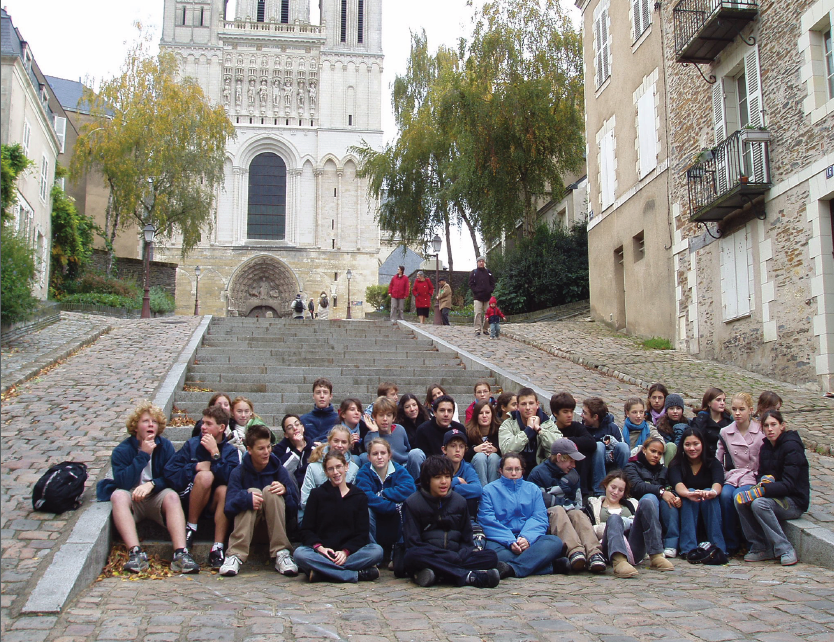
References
Byrnes, M. (2018) Was Dewey right? Are schools a reflection of society? NAIS Magazine. Retrieved from https://www.nais.org/
Decoo, W. (2011). Systemization in foreign language teaching: Monitoring content progression. Journal of Second Language Teaching and Research, 1(2), 159 –162.
Dewey, J. (1909). Moral principles of education. Retrieved from Project Gutenberg EBook Douthat, R. (2018, August 8). Oh, the humanities! The New York Times. Retrieved from https://www.nytimes.com/
Gobry, P-E (2014, March 21). Want to know the language of the future? The data suggests it could be … French. Forbes. Retrieved from https://www.forbes.com
Graham, S. (2004). Giving up on foreign languages? Students’ perceptions of learning French. The Modern Language Journal, 88(ii), 171-188.
Greene, R. L. (2012, March/April). Which is the best language to learn? 1843 Magazine. Retrieved from https://www.1843magazine.com/
Karabulut, A. & LeVelle, K. & Jinron, L. & Ruslan S. Technology for French learning: A mismatch between expectations and reality. Calico Journal, 29(2), 341-366.
Lazaruk, W. (2007). Linguistic, academic, and cognitive benefits of French immersion. The Canadian Modern Language Review/La Revue canadienne des langues vivantes, 63(5), 605–628.
Lomicka, L. (2009). An intercultural approach to teaching and learning French. The French Review, 82(6), 1227-1243.
Mady, C. (2015). Immigrants outperform Canadian-born groups in French immersion: Examining factors that influence their achievement. International Journal of Multilingualism, 12(3), 298–311. http://dx.doi.org/10.1080/14790718.2014.967252
Newman, C. (Winter 2006-2007). A preface to Waring: What it means to belong. Journal, 4(2), 5-7.
Nicolay, A. , & Poncelet, M. (2013). Cognitive advantage in children enrolled in a second-language immersion elementary school program for three years. Cambridge University Press, 16(3), 597-607. https://doi.org/10.1017/S1366728912000375
No author. (2018). Why study a language? Ohio State University Center for languages, literatures and cultures. Retrieved from https://cllc.osu.edu/undergraduate/why
No author. (2018). 10 good reasons for learning French France Diplomatie. Retrieved from https://www.diplomatie.gouv.fr/
Gobry, P-E. (2014, March 21). Want to know the language of the future? The data suggests it could be …French. Forbes. Retrieved from https:// www.forbes.com/
Reynolds, G. (2018, August 16). How exercise could help you learn a new language. The New York Times. Retrieved from https://www.nytimes.com/
Parsons, J. (2018, March 8). The place where we are right . Retrieved from Meditation presented to Gloucester Universalist Unitarian church
Smick, A. (2004). Never in English. Presentation to the Massachusetts Foreign Language Association: MaFLA teacher conference.
Swain, M. & Lapkin, S. (1998). Interaction and second language learning: Two adolescent immersion students working together. Modern Language Journal, 82(iii), 320-333.



